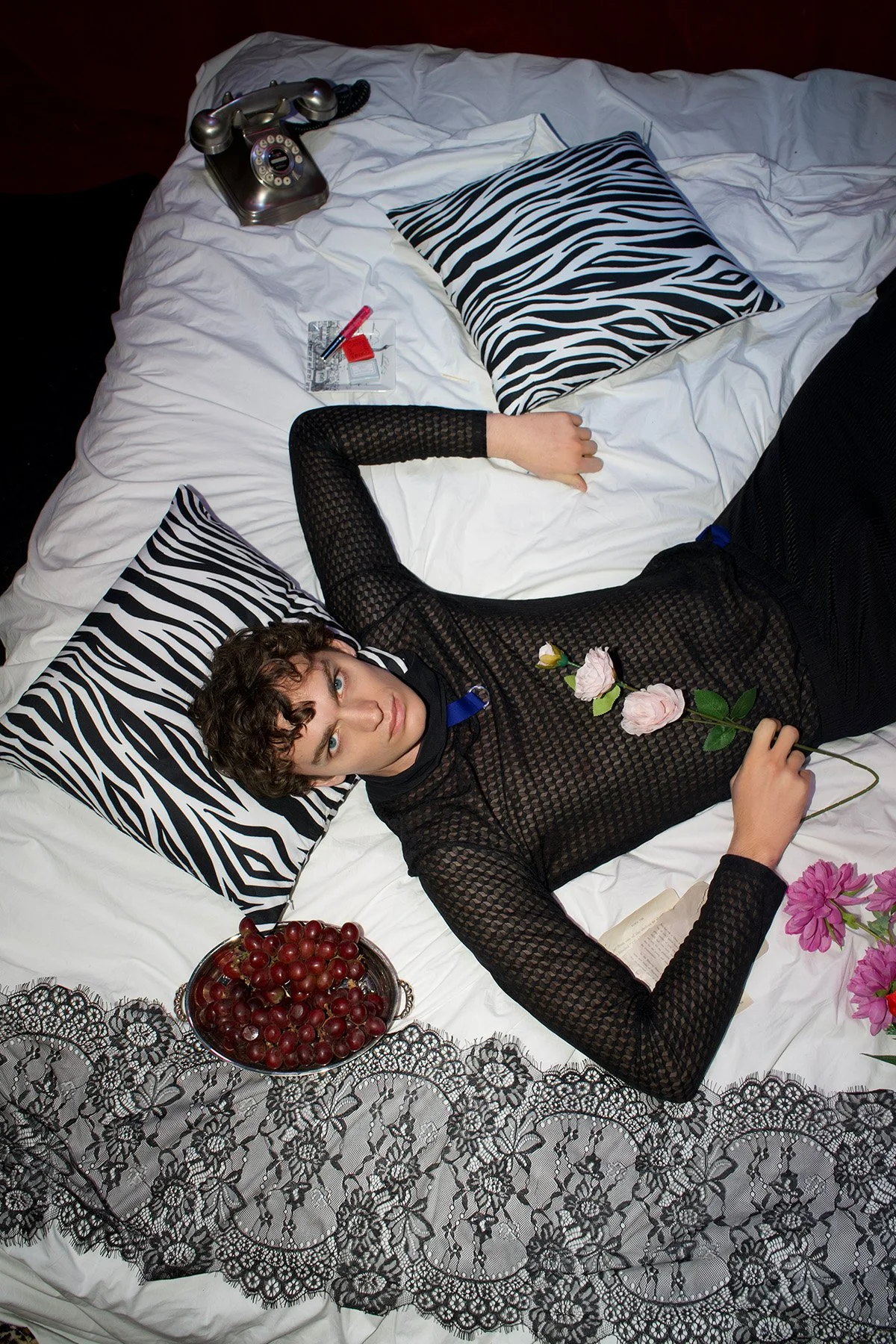SOMBRE LAUNCH FILM: "MINUIT"90s version.
As the initiator of this project, I took on the responsibility of shaping the campaign film for my brand. I developed the base story and defined key visual, editing, camera, and set references. Once the initial concept was in place, I brought in Kiana Dittman to direct and Pooja Appanna for production. Our collaboration was close and hands-on throughout the process. I made all final decisions, managing the project remotely and overseeing the organization of the shoot. A month before filming, I traveled to New York to handle fittings, source set elements, and finalize the cast. The final shoot spanned two days, across three locations, and involved over 30 people in total.
Script Development
I began the script with the aim of introducing SOMBRE's narrative of finding escape and liberation through darkness. The addictive and harmful nature of screens—constantly feeding anxiety, self-comparison, and anger—is something I wanted my character to break free from. Starting the film with her in front of a TV became an aesthetic choice to represent this feeling. The blue ribbons on the clothes, symbolic of scars and traumas, were mirrored in the script by tying Anna to the TV, intensifying the sense of her being stuck.
SOMBRE’s arrival, prompted by the clock striking midnight, felt like the perfect cultural and rational symbol of transition—both for the night and a new beginning. The story then moves to an underground party, inspired by the eclectic 80s disco and 20s rave scenes, where liberation is found in freedom and frantic energy. I introduced an ally for Anna—someone with an unspoken connection, ambiguous yet intimate, guiding her through this new world.
As the party intensifies, flashes of Anna in her original bedroom remind the viewer that her liberation is both mental and physical.
Visual Look
When it came to deciding the visual look of the film in terms of lighting and camera work, my main goal was to create a strong contrast between a sad, anxious space and an exciting, frantic, yet somewhat unsettling one. For the first space, I drew inspiration from films like Trainspotting and music videos such as Marry the Night by Lady Gaga. For the second space, my biggest influences were Gaspar Noé's work and Only God Forgives by Nicolas Winding Refn. Colors were used both to enhance the eclectic atmosphere of the party and to mirror the character's emotional journey. The camera work, influenced by Enter the Void and Climax, was designed to feel smooth, organic, yet chaotic—capturing the intensity of the experience.
When it came to finding a location and designing the set, I wanted a space that seemed alive in its decay—half-destroyed, yet pulsating with a strange, gritty energy. The mismatched furniture and flickering neon signs gave it an eerie, underground vibe, where the line between surreal and real blurred in the hazy glow of colored lighting. This aimed to convey the brand’s message that true luxury isn’t found in pristine surroundings, but in the raw, electric energy of a space.
Characters
The character naturally evolved into a symbol of both myself and my brand. The relationship between Paris and New York, fundamental to my personal identity and central to the brand’s design philosophy, was embodied by Camille Bavera—born in Italy, and later spending much of her life in the U.S. When casting, I knew instantly that she was the one. Her haircut evoked Jean Seberg in Breathless, who famously portrayed an American living in Paris. We visually referencedBreathless in the opening scene, where "SOMBRE" is spelled out on the wall using matchboxes, similar to Jean Seberg’s bedroom, where she had "POURQUOI?" written in cigarette packs.
Original Music
Music was a central inspiration for the film, and hyperpop felt like the genre that most embodied its message. I provided our composer, Alexandre Clouzard, with five reference tracks to guide the composition: "Ssx" and "4up7up" by The Hellp, "Tired and Sick" by Otha, "Again" by Snow Strippers, and "Klepto" by Sam Quealy. These references emphasized electronic sounds, high BPM, and helped convey the emotional tone of the music. I gave him the following direction:
The core idea behind SOMBRE is finding freedom amidst the growing chaos around us. As the world races, we dance to its rhythm. The track should echo this sentiment. The rhythm should gradually accelerate, mirroring the world's hurried pace. But instead of being overwhelmed by the chaos, we find our groove in the speeding beats. The faster things move, the more liberating and joyful our expression becomes. It’s about celebrating the accelerated rhythm of life and letting it guide us in unscripted, exhilarating ways.
Production
This project demanded resourcefulness to achieve our desired quality on a limited budget. I assembled a team of recently graduated film students whose potential stood out to me. Together with the director, we reached out to dozens of contacts until we built a capable team. Friends joined as extras and helped with set installation and breakdown, essential due to our tight constraints.
Our limited budget also affected the set design, but after scouring various options, we found a semi-abandoned Brooklyn church basement that was perfect. Each room had its own distinct vibe yet felt cohesive with minimal set decoration, aligning with our vision.
Post-production was another challenge, with only a month to complete editing, coloring, and scoring. As creative director, I worked closely with the director, who was also the editor, and the composer. When tensions arose, I played a key role in finding compromises that balanced everyone’s input while ensuring the final product stayed true to my vision.














